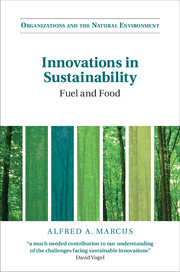Book contents
- Frontmatter
- Dedication
- Contents
- List of figure and tables
- Foreword
- Acknowledgments
- Introduction the path to sustainability
- Part I Funding sustainable startups
- 1 Leaders of the pack: Khosla Ventures and KPCB
- 2 Scaling up: Intel Capital and Google Ventures
- Part II Business models
- Part III The macroenvironment and industry context
- Part IV Finding customers
- Part V Competition between mission and non-mission based businesses
- Concluding observations: the journey continues
- Index
1 - Leaders of the pack: Khosla Ventures and KPCB
from Part I - Funding sustainable startups
Published online by Cambridge University Press: 05 August 2015
- Frontmatter
- Dedication
- Contents
- List of figure and tables
- Foreword
- Acknowledgments
- Introduction the path to sustainability
- Part I Funding sustainable startups
- 1 Leaders of the pack: Khosla Ventures and KPCB
- 2 Scaling up: Intel Capital and Google Ventures
- Part II Business models
- Part III The macroenvironment and industry context
- Part IV Finding customers
- Part V Competition between mission and non-mission based businesses
- Concluding observations: the journey continues
- Index
Summary
Khosla Ventures and Kleiner Perkins Caufield & Byers (KPCB) were the leading venture capital (VC) investors in clean energy. They had to assess what they would do next. To what extent did the clean energy sector continue to be attractive? To what extent should they continue to invest in it? If they continued to invest, which categories should they emphasize? At what stage in the maturation of a startup should they concentrate their investments?
Clean energy consisted of energy efficiency, solar, alternative modes of transportation and energy storage, biofuels, and wind and agricultural technologies that had the potential to reduce reliance on fossil fuels such as coal and oil. These sustainable technologies had the potential to reduce noxious emissions, lower the chances of climate change, and decrease dependence on a commodity imported from unstable regions of the globe. They also might be able to build new industries and create jobs. The US Department of Energy (DOE) projected that the US and world economies would continue to be largely dependent on fossil fuels into the foreseeable future. Clean energy's use expanded under the DOE's business-as-usual scenario, but its impact was not transformative. This forecast, however, could change, if clean energy made a series, or even single, major leap forward. Venture capitalists (VCs) might partially or fully fund a disruptive movement in the way energy was produced and consumed that was similar in impacts to the revolution that took place when the Internet took off. Since startups with game-changing technologies rarely had the money they needed to finance their growth and development, they often depended on VC funding.
- Type
- Chapter
- Information
- Innovations in SustainabilityFuel and Food, pp. 13 - 49Publisher: Cambridge University PressPrint publication year: 2015



